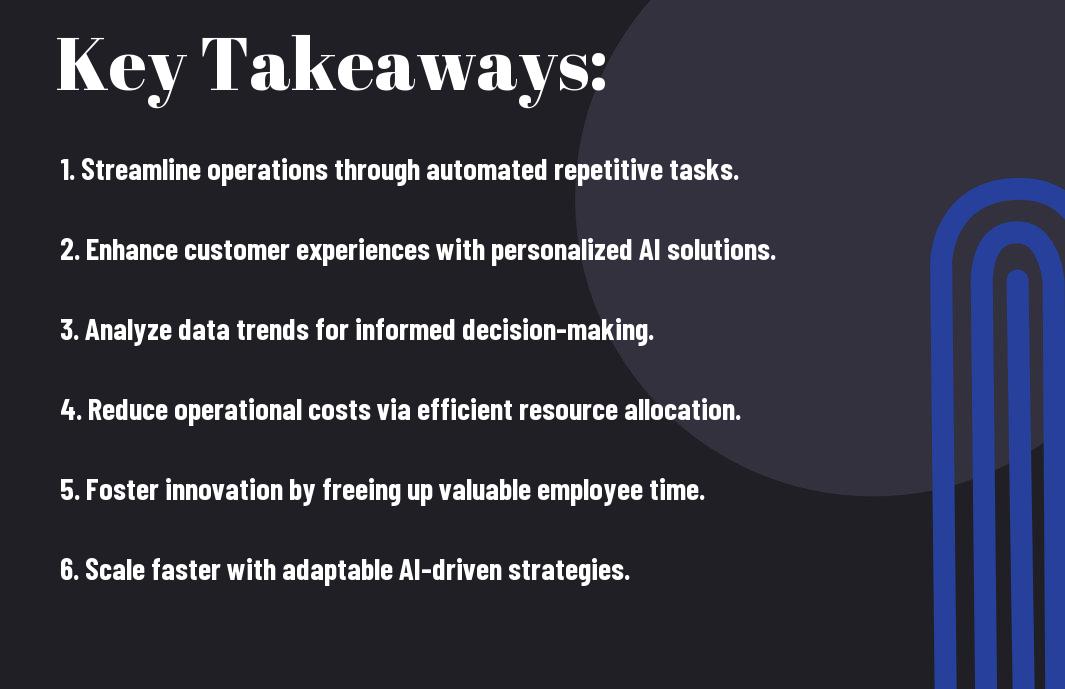
Most business owners are now turning to artificial intelligence (AI) and automation as powerful tools to enhance efficiency and foster growth. By integrating these technologies into your operations, you can streamline processes, reduce human error, and free up valuable time to focus on strategic decisions. In this post, we’ll explore how you can effectively harness AI and automation to not only scale your business but also create a more agile and competitive enterprise in today’s fast-paced market.

Understanding AI and Automation
The landscape of business is being transformed by the advancements in artificial intelligence (AI) and automation. These technologies streamline operations, enhance decision-making, and improve customer experiences. By grasping the fundamentals of AI and automation, you can better position your company for sustained growth and competitiveness in today’s market.
Definitions and Key Concepts
The core of AI involves algorithms that enable machines to mimic human intelligence, processing vast amounts of data to make informed decisions. Automation refers to the use of technology to carry out tasks without human intervention, optimizing efficiency and accuracy. Together, these concepts form the backbone of modern business strategies.
The Role of AI in Modern Business
The integration of AI into business operations has the potential to revolutionize efficiency, innovation, and customer engagement. With AI-driven analytics, you can make data-informed decisions that enhance productivity and streamline your processes.
It enables you to predict market trends, personalize customer interactions, and automate routine tasks, freeing up your team to focus on more strategic initiatives. By leveraging AI, you can enhance your competitive edge, driving growth and profitability while also delivering exceptional value to your customers.
Benefits of Leveraging AI and Automation
While we navigate a rapidly changing business landscape, leveraging AI and automation can significantly enhance your operations. These technologies not only streamline processes but also empower you to focus more on strategic decision-making and growth. Embracing such innovations helps you stay competitive and responsive to market demands.
Increased Efficiency and Productivity
Benefits of incorporating AI and automation into your business model include improved efficiency and productivity. By automating routine tasks, you free up valuable time for your team to concentrate on higher-value activities, ultimately leading to faster project completion and enhanced output.
Cost Reduction and Resource Allocation
Above all, utilizing AI and automation can lead to significant cost reductions and improved resource allocation. With smarter technologies analyzing data and optimizing workflows, you can minimize operational expenses and direct your resources toward growth initiatives that truly matter.
Further, by streamlining your operations through AI-driven insights, you can identify areas of waste and inefficiency. This allows you to allocate resources more effectively, ensuring that each dollar spent is contributing to your business’s core objectives. As a result, you’ll enhance your profitability while also maximizing your team’s capabilities, creating a more sustainable and agile business model.
Implementing AI and Automation Strategies
Many businesses are realizing the potential of AI and automation to optimize operations and enhance efficiency. By strategically implementing these technologies, you can streamline processes, reduce costs, and scale your business more effectively. It’s crucial to approach this transition thoughtfully, ensuring you align your automation goals with your business objectives to maximize the benefits.
Identifying Areas for Automation
Below are some key steps to identify areas where automation can bring significant improvements. Start by analyzing your current workflows and processes, looking for repetitive tasks that consume valuable time. Talk to your team to understand pain points and areas that slow down productivity. This insight will help you pinpoint specific functions that automation can enhance, freeing up resources for more strategic initiatives.
Choosing the Right Tools and Technologies
Below, you’ll find crucial considerations for selecting the most suitable tools and technologies to implement automation in your business. Evaluate various software and platforms based on factors such as ease of integration, scalability, and user-friendliness. Ensure that the tools you choose align with your current processes, and consider solutions that offer flexibility to adapt as your business grows.
Identifying the right tools begins with understanding your specific business needs. Research various software options, and take advantage of trial periods to test functionality. Opt for platforms that offer robust support and updates, ensuring they remain relevant as technology evolves. By selecting the right tools, you empower your team with the capabilities to automate and streamline key processes, ultimately driving your business growth.
Overcoming Challenges in Adoption
Your journey to integrating AI and automation into your business can encounter hurdles. Identifying potential challenges early on allows you to devise effective strategies to mitigate them. Addressing both workforce concerns and data privacy issues head-on will help to ensure a smoother transition. By doing so, you position your business for sustainable growth while reducing resistance from your team and safeguarding sensitive information.
Addressing Workforce Concerns
Concerns about job displacement and skill gaps can hinder employee enthusiasm for AI adoption. By fostering an environment of open communication, you can alleviate fears by emphasizing how these technologies will enhance, rather than replace, their roles. Encouraging upskilling and reskilling initiatives also helps your workforce feel empowered and prepared for the changes ahead.
Data Privacy and Security Considerations
Around the rapid advancement of AI technologies, data privacy and security have emerged as significant considerations. You must ensure that the AI solutions you employ comply with relevant regulations and standards to maintain customer trust and the integrity of your data. Navigating these complexities is necessary for successful implementation.
Security measures must be robust, involving encryption, access controls, and regular audits to protect sensitive information. Additionally, adhering to industry best practices when handling customer data can help you avoid breaches and reputational damage. By prioritizing these considerations, you create a safer environment for both your business and your customers, fostering confidence as you adopt AI solutions.
Case Studies of Successful Implementation
After examining various business landscapes, the successful implementation of AI and automation can be observed in numerous case studies. These examples demonstrate how leveraging these technologies can lead to significant growth:
- A retail chain increased sales by 30% after deploying AI-driven customer insights.
- A logistics company reduced delivery times by 25% using route optimization algorithms.
- A healthcare provider saved 40% in operational costs by implementing robotic process automation.
- A fintech startup doubled its customer base in six months through automated marketing strategies.
Small Businesses Scaling with AI
Between 2018 and 2023, small businesses leveraging AI tools reported an average revenue growth of 20%. By adopting chatbots for customer service, AI-driven inventory management, and targeted marketing campaigns, you can optimize resources and enhance customer interactions, positioning your enterprise for scalable growth.
Large Enterprises and Automation Strategies
On the other hand, large enterprises have reaped the rewards of automation strategies in various ways. Many organizations have embraced AI to streamline operations, improve efficiency, and reduce overhead costs. This strategic approach allows them to allocate resources more effectively and innovate within their core business areas.
Implementation of automation in large enterprises often involves integrating sophisticated software systems, including AI-based analytics and machine learning algorithms. These technologies facilitate data-driven decision-making, enhance the customer experience, and create agility in processes. You can harness these tools to redefine workflows and drive your organization toward higher profitability and sustainability.
Future Trends in AI and Automation
All signs point to AI and automation fundamentally reshaping business dynamics in the coming years. As these technologies continue to evolve, they will enhance decision-making capabilities, streamline processes, and personalize customer experiences like never before. You should stay ahead by anticipating these transformations to leverage the full potential of AI and automation for your business growth.
Emerging Technologies to Watch
To capitalize on future opportunities, keep an eye on developing technologies such as quantum computing, advanced robotics, and natural language processing. These innovations are set to revolutionize industries by enhancing computational power and improving interaction between machines and humans, which benefits your business strategies.
Predictions for Business Landscape
Emerging trends in AI suggest that businesses will increasingly rely on data-driven insights to tailor their offerings and enhance efficiency. Automation will not only boost productivity but also create new roles focused on managing these intelligent systems. As these shifts unfold, you can expect a heightened emphasis on agility and adaptability in your business operations.
Technologies like machine learning and predictive analytics will enable your business to anticipate market shifts and consumer preferences effectively. As businesses harness AI for personalization, you may find your organization empowered to create more meaningful connections with customers. The growing reliance on intelligent systems will also refresh workforce skills, prompting you to engage in continuous learning and innovation to maintain competitiveness in an evolving marketplace.
Summing up
Ultimately, leveraging AI and automation can significantly enhance your business’s scalability and efficiency. By integrating these technologies into your operations, you can streamline workflows, reduce costs, and improve decision-making. This transformation allows you to focus on strategic growth while AI handles routine tasks. As you embrace these advancements, you position your business to thrive in an increasingly competitive landscape, maximizing both productivity and innovation.
Leave a Reply